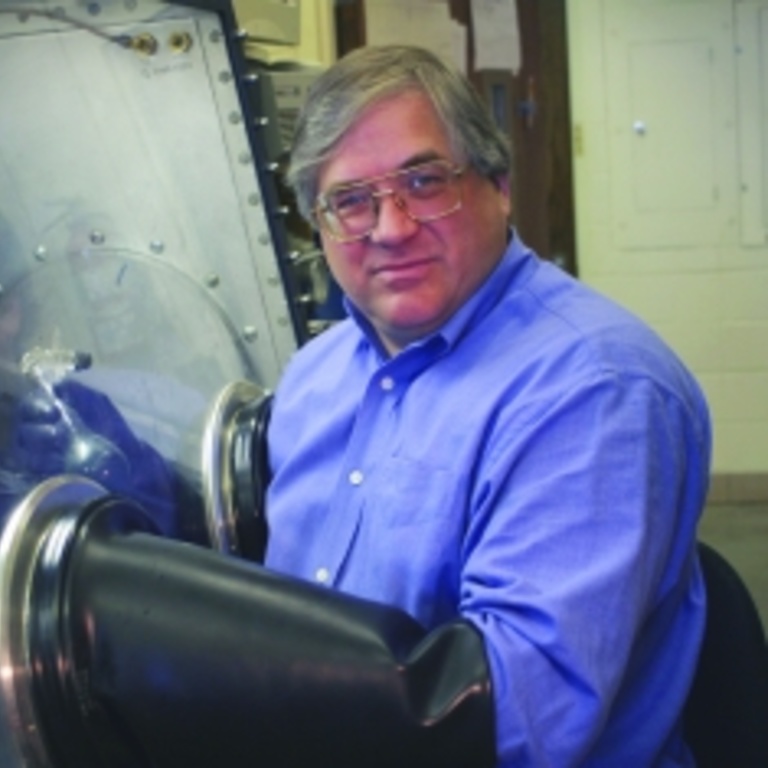Lou Messerle
Keywords
- Transition metal clusters
- Reactivity of metal-metal multiple bonds
- Early actinide organometallics
Research interests
The synthesis, structure, and reactivity of novel, coordinatively and electronically unsaturated organotransition metal complexes and of metal cluster compounds of the early transition metals, high atomic number main group elements, and lanthanides are the major interests of my research group. Mid-valent organometallic and cluster chemistries of these elements are underdeveloped areas with considerable practical utility.
In organometallic chemistry, we are studying the reactivity of catalysis-relevant functional groups, e.g., metal-metal double and triple bonds in mono(permethylcyclopentadienyl) (C5Me5, Cp*)M and bridging ligand environments. Reactions of interest include reductive dimerization, CO insertion, hydrocarbon C-H bond activation, and reduction leading to altered functional group reactivity. Much of this chemistry is focused on the third-row transition metal elements hafnium, tantalum, tungsten, and rhenium. For example, we have explored the substantial small-molecule reactivity of the tantalum-tantalum doubly-bonded Cp*2Ta2(µ-X)4(X = Cl, Br), which reacts under mild conditions with olefins (intermolecular C-H activation), cumulenes (e.g., allene), borohydride B-H activation to diborane(2-) ligands), dihydrogen (H-H cleavage), dinitrogen (with four-electron reduction of the N2 ligand), and cyclopropenes. The allene adduct Cp*2Ta2(µ-Cl)Cl3[C(CH2)2] undergoes a double C-H activation to the first example of an allenediyl ligand, HCCCH, upon reduction.
We are also developing metal cluster chemistry of tungsten, tantalum, bismuth, gadolinium, and europium relevant to new classes of diagnostic medical imaging contrast agents for CT and MR imaging. This research involves cluster synthesis, chelating ligand coordination, bioconjugation to targeting moieties, and in vitro and in vivo imaging in collaboration with researchers in the UI Carver College of Medicine. We have recently prepared new W3, Ta3, Bi9, Gdn(n = 12, 14, 15), and large Y60 clusters and have found convenient new routes to known Ta6, Mo6, and W6 clusters. These compounds are new paradigms for multiplied X-ray contrast and/or magnetic resonance relaxivity in noninvasive biomedical imaging.
Experimental methods include inert atmosphere techniques (glove box, Schlenk line), IR, high-field multinuclear NMR spectroscopies, mass spectrometry, single-crystal and powder X-ray diffractometry, and MO calculations.
Recent publications
- Kolesnichenko, V.; Hay, D.N.T.; Swenson, D.C.; Messerle, L. W3Cl10(Hg2Cl2)2, A Reactive 1-D Polymer of Triangular Tritungsten Clusters with Terminal and Intercluster-Bridging Mercurous Chloride Ligands: Main Group Metal Halide By-Products as Versatile Ligands in Reductive Synthesis of Early Transition Metal Halide Clusters. J. Cluster Sci. 2010, 21, 515-523. (invited)
- Thurston, J.H.; Dougherty, M. J.; Swenson, D.C.; Messerle, L. [Bi5(dpd)6⊂CH3CN](ClO4)3, a Supramolecular, Tetrahedral Pentabismuth Cluster Derived from a Nonasbismuth Oxo/Hydroxide. Dalton Trans. (communication), 2008, 5146-8.
- Lee, T. Y.; et al. Four-Electron Reduction of Dinitrogen during Solution Disproportionation of the Organodimetallic (η-C5Me4R)2Ta2(μ-Cl)4 (R = Me, Et) to a New μ-η1, η2-N2 Complex and Odd-Electron Organotrimetallic Cluster. Chem. Commun. 2005, 5444-5446.
- Thurston, J.H.; Swenson, D.C.; Messerle, L. “Solvolytic Routes to New Nonabismuth Hydroxy- and Alkoxy-oxo Complexes: Synthesis, Characterization, and Solid-State Structures of Novel Nonabismuth Polyoxo Cations Bi9(µ3-O)8(µ3-OR)65+ (R = H, Et). Chem. Commun. 2005, 4228-4230.
- Huang, J.H.; Luci, J.J.; Lee, T.Y.; Swenson, D.C.; Jensen, J.H.; Messerle, L. A Planar Tetra-coordinate Carbon and Unusual Bonding in an Organodimetallic Propynylidene Complex Arising from Double C-H Activation of an Allene Ligand. J. Am. Chem. Soc. 2003, 125, 1688-9.
- Hay, D.N.T.; Swenson, D.C., Messerle, L. Gallium and Gallium Dichloride, New Solid-State Reductants in Preparative Transition Metal Chemistry. New, Lower–Temperature Syntheses and Convenient Isolation of Hexatantalum Tetradecachloride Octahydrate, Ta6(μ–Cl)12Cl2(OH2)4.4H2O, and Synthesis and Solid-State Structure of a Tetraalkylammonium Derivative, [N(CH2Ph)Bu3]4[Ta6(µ-Cl)12Cl6], of the Reduced [Ta6(µ-Cl)12]2+ Cluster Core. Inorg. Chem. 2002, 41, 4700-4707.
- Mullan, B.F.; Madsen, M.T.; Messerle,L.; Kolesnichenko, V.; Kruger, J. X-ray Attenuation Coefficients of High Atomic Number Transition Metal Cluster Compounds: A New Paradigm for Radiographic Contrast Agents. Acad. Radiol. 2000, 7, 254-260.
- Messerle, L. Intermolecular Vinylic C-H Bond Activation by a Doubly-Bonded Organoditantalum Complex. J. Am. Chem. Soc. 1987, 109, 6506-6508.
- Messerle, L. Metal-Metal Bonded Dinuclear and Organodimetallic Complexes of the Early Transition Metals (Groups 4 and 5): Synthesis, Structure, and Reactivity. Chem. Rev. 1988, 88, 1229-1254 (invited)
- Inorganic chemistry
